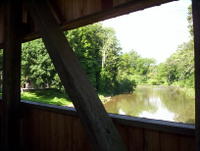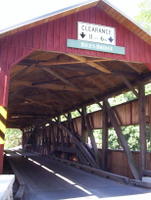
On the way to breakfast the other day, i stopped to snap some photos of Rice's Bridge, near Landisburg, Perry County, Pennsylvania, USA. pretty and practical structure, isn't it?
"This bridge is located in Tyrone Twp., on Kennedy Valley Road. It crosses Sherman's Creek. The bridge was built in 1869. It is 132 feet long and 18 feet wide."


"The construction of the bridge is unusual; it uses a combination of Queenpost trusses and Burr-arch trusses. Beneath the large burr-arch are located 2 small Queenpost trusses."


Donna. Thanks for the lovely pictures. Could go and surf and find out, but thought I'd ask instead. Why are the bridges covered? Thanks.
ReplyDeletewow :) great question as to why bridges were built with walls and roofs... hmmmm.... i don't really know. they are just sumthin' i grew up with and never really thought about why they are. but....
ReplyDeletenow that ya got me thinking about it....
hmmmmm, maybe, it has something to do with when they were originally built.... during the days of horse-and-open-buggy transportation and the fact that in our Pennsylvanian temperate climate of sun, rain, snow and other weather factors induced by the changing of seasons which affect roadways, covered bridges made taversing roadways over streams and rivers safer for travelling? you know, open bridges tend to freeze more quickly than covered/protected road surfaces.
?
dang, i like this question. a lot. i now want to find out more about 'why' covered bridges are. i just always appreciated them as beautiful structures indigenous to my home.... but, never thought about why they are.
not, until now
:)
ok! here's what i found out.....
ReplyDeleteit's for a very practical reason relating to architectural integrity.
"While covered bridges are sometimes called kissing bridges, the real reason for the covering is to protect the bridge's truss design from the weather."
and
"Covered bridges were constructed to withstand heavy rains and salty sea air. High-quality timber was more accessible in this area than was more costly steel and concrete. Covered bridges are similar in design to steel truss bridges, however, the shortage of steel during World War I contributed to the need to use wood as bridge building material. House-type structures over these wooden bridges protect the wood trusses and floor planking from the elements and more than doubles the life expectancy of the bridge. As early as 1918, plans for covered bridges had become standardized to include open windows for light and ventilation together with such features as laminated floors and interior whitewashing. The covered bridges still standing represent many hours of skilled hand labor."
here's another interesting tidbit of info...
"Pennsylvania is often recognized as the birthplace of covered bridge building. From the 1820s to 1900 there were about 1500 covered bridges built in Pennsylvania. Because many state residents realize the importance of these historic bridges, Pennsylvania has the largest number of covered bridges in the nation. Today 219 bridges remain in 40 counties (Pennsylvania has a total of 67 counties)."
and, btw, no, i don't think this covered bridge was in any movies. i'm guessing you're thinking of the film "The Bridges Of Madison County" with Clint Eastwood and Meryl Streep.
Thanks Donna. Thought it might be something like that - but sorry, think I prefer the kissing bridge reason, much more romantic. Fits in with "The Bridges of Madison County" too.
ReplyDeleteDidn't realise they were made of wood. Amazing they still stand.